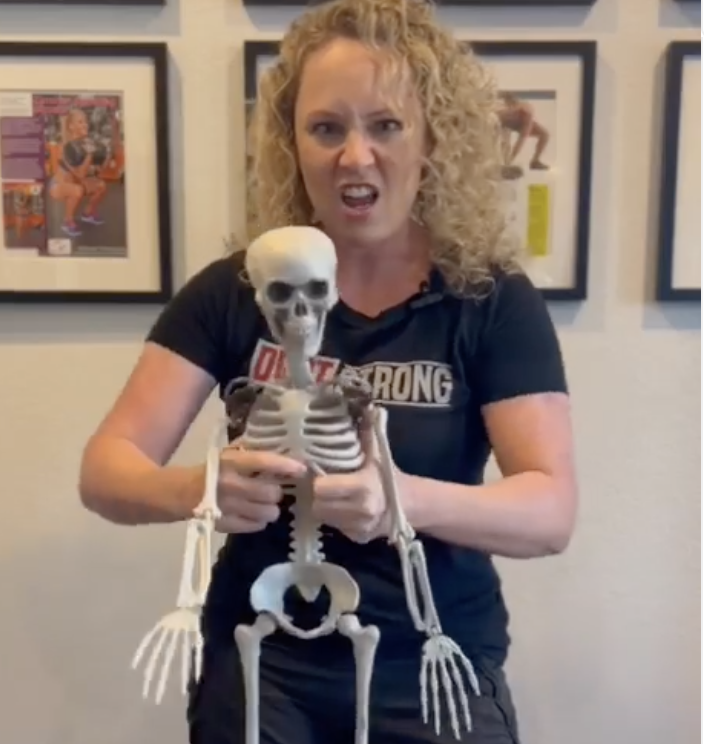How Social Media Knee Pain Solutions Are Hurting Your Knees
2024-12-1
Jessica Bento, Physical Therapist (Creator DVRT Restoration Certification, DVRT Rx Shoulder, Knees, Pelvic Control, & Gait Courses)

I understand why people often default to focusing on the quadriceps when dealing with knee pain. The quads have a direct connection to the knee, and there’s substantial research showing that strengthening them can positively impact knee pain (1, 2). However, addressing knee pain solely through quadriceps strengthening isn’t the most effective approach.
Why? Because research also shows that strengthening the hamstrings (3, 4), hips (5, 6), core (7, 8), and feet (9, 10), along with improving ankle mobility (11, 12), all play crucial roles in alleviating knee pain. This highlights the interconnectedness of the body and suggests that focusing exclusively on the quads is unlikely to deliver optimal results.

For many, even with compelling evidence, old habits die hard. I get it—it can be tough to rethink long-held beliefs about treating knee pain. But it’s important to understand the bigger picture. Training each contributing factor in isolation isn’t ideal. Evidence supports a more integrated approach, which I advocate not only as a physical therapist with 20 years of experience but also because of what the research indicates (13, 14, 15).
For instance, some claim that the reverse Nordic leg curl is excellent for knee pain because it strengthens the quadriceps and improves flexibility. Yet studies show it doesn’t enhance quadriceps activation more than a bodyweight squat and performs worse than a single-leg squat in this regard. Similarly, the “Spanish squat” is often used in early rehab stages to reduce shin movement and shear forces, but it directly contrasts with the knees-over-toes philosophy, which increases these forces. This contradiction illustrates the confusion surrounding knee pain exercises.
View this post on Instagram
View this post on Instagram
There’s a lot of misunderstanding about the science and context of knee pain. I hope posts like these, along with my DVRT Knee programs, can provide clarity and actionable solutions (like I offer in my DVRT Rx Knee pain courses HERE). Pain doesn’t have to dictate your life—and recovery can be purposeful, progressive, and achievable without relying on “trendy” exercises.
Don’t miss the last 2 days to save 30% all throughout DVRT with big savings on physical therapist, Jessica Bento’s DVRT Rx corrective exercise programs, our online certifications, masterclasses, online workout programs, and when you save 30% on our Ultimate Sandbags and Water Bags you will ALSO get 2 1/2 hours of follow along workouts HERE with code “save30”
View this post on Instagram
References:
1. Shen, Peng, et al. “Analysis of Quadriceps Strength and Knee Pain.” Archives of Physical Medicine and Rehabilitation 105.10 (2024): 1900-1907.
2. O’reilly, Sheila C., et al. “Quadriceps weakness in knee osteoarthritis: the effect on pain and disability.” Annals of the rheumatic diseases 57.10 (1998): 588-594.
Hafez, Ashraf Ramadan, et al. “Treatment of knee osteoarthritis in relation to hamstring and quadriceps strength.” Journal of physical therapy science 25.11 (2013): 1401-1405.
3.Hafez, Ashraf Ramadan, et al. “Treatment of knee osteoarthritis in relation to hamstring and quadriceps strength.” Journal of physical therapy science 25.11 (2013): 1401-1405.
4. Lopes, Helder S., et al. “There is more to the knee joint than just the quadriceps: A systematic review with meta-analysis and evidence gap map of hamstring strength, flexibility, and morphology in individuals with gradual-onset knee disorders.” Journal of sport and health science 13.4 (2024): 521-536.
5. Lun, Victor, et al. “Efficacy of hip strengthening exercises compared with leg strengthening exercises on knee pain, function, and quality of life in patients with knee osteoarthritis.” Clinical Journal of Sport Medicine 25.6 (2015): 509-517.
6. Rathleff, Michael Skovdal, et al. “Is hip strength a risk factor for patellofemoral pain? A systematic review and meta-analysis.” British journal of sports medicine 48.14 (2014): 1088-1088.
7. Ferber, Reed, et al. “Strengthening of the hip and core versus knee muscles for the treatment of patellofemoral pain: a multicenter randomized controlled trial.” Journal of athletic training 50.4 (2015): 366-377.
8. Foroughi, Forouzan, et al. “Added value of isolated core postural control training on knee pain and function in women with patellofemoral pain syndrome: a randomized controlled trial.” Archives of physical medicine and rehabilitation 100.2 (2019): 220-229.
9. Kısacık, Pınar, et al. “Short foot exercises have additional effects on knee pain, foot biomechanics, and lower extremity muscle strength in patients with patellofemoral pain.” Journal of back and musculoskeletal rehabilitation 34.6 (2021): 1093-1104.
10. Mølgaard, Carsten M., et al. “Foot exercises and foot orthoses are more effective than knee focused exercises in individuals with patellofemoral pain.” Journal of science and medicine in sport 21.1 (2018): 10-15.
11. Lima, Yuri Lopes, et al. “The association of ankle dorsiflexion and dynamic knee valgus: A systematic review and meta-analysis.” Physical Therapy in Sport 29 (2018): 61-69.
12. Dudziński, Krzysztof, Marta Mulsson, and Anna Cabak. “The effect of limitation in ankle dorsiflexion on knee joint function. A pilot study.” Ortopedia traumatologia rehabilitacja 15.2 (2013): 159-168.
13. Gbiri, C. A., U. A. C. Okafor, and M. T. Alade. “Comparative Efficacy of Open-chain and Close-chain Kinematics on Proprioception, Muscles’ Strength and Functional Performances in Individual with Knee Osteoarthritis.” Occup Med Health Aff 1.1 (2013): 1-5.
14. Bakhtiary, Amir H., and Elham Fatemi. “Open versus closed kinetic chain exercises for patellar chondromalacia.” British journal of sports medicine 42.2 (2008): 99-102.
15. Fehr, Guilherme Lotierso, et al. “Effectiveness of the open and closed kinetic chain exercises in the treatment of the patellofemoral pain syndrome.” Revista Brasileira de Medicina do Esporte 12 (2006): 66-70.
© 2025 Ultimate Sandbag Training. Site by Jennifer Web Design.







